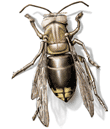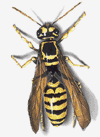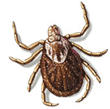Stinging & Biting
 Bumblebee - Subfamily Bombinae
Bumblebee - Subfamily Bombinae
Appearance: Ranges up to 1 inch in length. Usually black with yellow stripes on the thorax and abdomen. Often confused with carpenter bees, bumblebees are characterized by the hairiness of the abdomen .
Habits: As social insects, bumblebees live in colonies. The workers do produce honey, but it is not edible to humans. The colony grows larger over the summer and is usually discovered by a homeowner while gardening or mowing the lawn.
Diet: Pollen and nectar.
Reproduction: Each spring a queen that has survived overwintering will find a suitable nesting site and establish her colony. Her first brood of eggs mature into workers that forage on pollen and nectar for food.
Other Information: Unlike honey bees, bumblebees rarely sting. This makes it is quite easy and safe to have a close look at them.
 Africanized Honeybee - Apis mellifera scutellata
Africanized Honeybee - Apis mellifera scutellata
Appearance: About 1/2-inch in length. Golden-yellow with darker bands of brown. Some specimens appear a darker brown than others.
Habits: Africanized honeybees are actually a subspecies of the European honeybee, and the two look exactly the same. The difference, however, becomes readily apparent in their aggressiveness when the colony is disturbed, lending to their nickname "killer bees." They will chase and sting people for hundreds of yards and have been known to sting people and pets over a whole neighborhood block. Deaths may occur due to allergic reactions from the larger number of stings received. It may take hours for the bees to settle down and return to the colony.
Diet: These bees forage on pollen and nectar from flowering plants and use these materials to produce the honey that will feed the colony through the winter months.
Reproduction: All honeybee colonies produce queens and drones in the spring. These reproductives mate, and the queens may "abscond" with a number of workers with which they start new colonies.
Other Information: Swarms may be seen clustered on a tree branch, a fence, or a building as the bees rest before flying off again to find a suitable nesting site. Usually, the bees in these swarms are docile and nonaggressive unless vigorously disturbed.
Bald-Faced Hornet - Dolichovespula maculata
Appearance: Bluish-black with white markings on its face, thorax and abdomen. These large wasps are called bald-faced hornets, because of their white markings.
 Habits: Bald-faced hornets are not true hornets at all; they are aerial yellow jackets. They construct paper nests made from wood harvested from logs and trees. The nest of the bald-faced hornet will take on a football shape, growing larger with time. Hornets will aggressively attack and sting any intruder threatening or disturbing the nest. Attacks usually do not occur until colonies get larger, beginning in July and running through the fall.
Habits: Bald-faced hornets are not true hornets at all; they are aerial yellow jackets. They construct paper nests made from wood harvested from logs and trees. The nest of the bald-faced hornet will take on a football shape, growing larger with time. Hornets will aggressively attack and sting any intruder threatening or disturbing the nest. Attacks usually do not occur until colonies get larger, beginning in July and running through the fall.
Diet: Consists mainly of other insects such as flies and bees. Bald-faced hornets will also feed on their yellow jacket relatives.
Reproduction: Each year in the fall, a nest produces numerous queens that fly out to find a protected site to overwinter. The following spring, each queen finds a site in a tree or shrub to begin constructing her nest. She forms a small paper nest inside in which she builds a paper "comb" and raises her first brood of larvae. The workers that emerge begin foraging for food, enlarging the nest, caring for the young and defending the colony.
Other Information: Unless a person is somewhat allergic to insect stings, a bald-faced hornet’s sting is no worse than any other wasp’s despite its large size.
 Yellow Jacket - Vespula spp.
Yellow Jacket - Vespula spp.
Appearance: About 3/4-to 1-inch in length. Generally small wasps with black and yellow stripes.
Habits: Yellow jackets are social insects that live in colonies containing thousands of individuals. Colonies are usually started by a single queen in the early spring. By midsummer, a colony located on or near a house is large enough to become a nuisance. These wasps will aggressively attack when their nest is disturbed, and can inflict painful stings.
Diet: Consists mainly of sap, sweet nectar and other sugar products. Will also eat other insects such as flies and bees.
Reproduction: Single queens will locate a hole underground in the spring and construct a golf ball sized nest of paper that is made by mixing wood fibers with her saliva. She lays eggs and cares for the grub-like larvae in the nest. The first generation of sterile female workers emerge in June and assume the care of the nest which allows the queen to concentrate on reproduction.
Other Information: Unlike the honeybee, which stings only one time and then dies, a single yellow jacket can sting many times. They are responsible for about one-half of all human insect stings.
Dog Tick - Rhipicephalus sanguineus
Appearance: May reach nearly 1/4-inch in length. After taking a blood meal, however, the female may measure about 1/2-inch or larger. Uniformly dark reddish brown with no markings.
 Habits: Brown dog ticks do not confine themselves to dogs but will also attach themselves to many other animals and people. On dogs, adult ticks are typically found on the ears and between the toes. Outdoors, a brown dog tick crawls up on grasses, shrubs, and other vegetation, then attaches itself to a passing host.
Habits: Brown dog ticks do not confine themselves to dogs but will also attach themselves to many other animals and people. On dogs, adult ticks are typically found on the ears and between the toes. Outdoors, a brown dog tick crawls up on grasses, shrubs, and other vegetation, then attaches itself to a passing host.
Diet: Blood; swell to a considerable size after feeding
Reproduction: Mating usually occurs while adult ticks are on the host animal; female hard ticks feed only once, and lay one large batch of up to 10,000 eggs; female soft tick will feed several times and lay 20 -50 eggs after each meal; eggs hatch in 19 to 60 days.
Other Information: It is known to transmit diseases to humans, including Rocky Mountain Spotted Fever, tularemia, human babesiosus, and human ehrlichiosis. In addition, the threat of bacterial infection is possible at the site of any tick bite, and, in rare cases, may even result in blood poisoning.
 Cat Flea - Centocephalides felis
Cat Flea - Centocephalides felis
Appearance: Black to brownish-black, about one-twelfth to one-sixteenth inch long; six legs, with many bristles on body and legs; flattened body.
Habits: Fleas are ectoparasites of animals, meaning they live on the outside of the body and need to feed on the blood of these animals in order to produce eggs. Found on cats and dogs year-round, but most common during warm and humid weather; readily attack and feed on humans; can jump as much as seven-eighth inch vertically, and 14 to 16 inches horizontally.
Diet: Blood
Reproduction: Female can lay about 25 eggs a day, and up to 800 eggs during her lifetime; fleas undergo complete metamorphosis, usually in 14 to 90 days.
Other Information: Carrier of many diseases; adults can live one to two months without feeding.